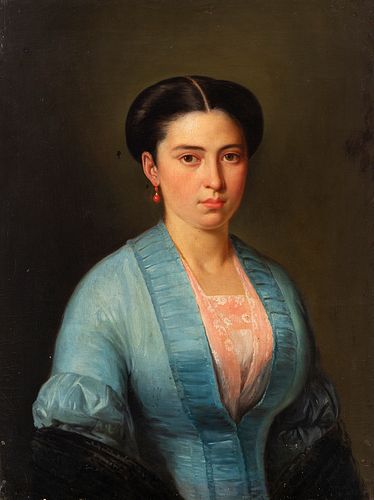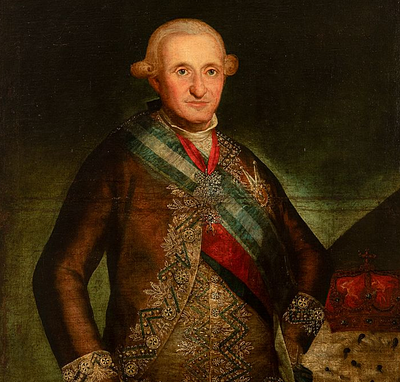CIRCLE OF CARLOS LUIS DE RIBERA (Rome, 1815-Madrid, 1891), circa 1850. "Portrait of a lady. Oil on canvas. Relined
Lot 52
About Seller
Setdart Auction House
Carrer Aragó 346
Barcelona
Spain
Setdart Subastas was born in 2004 and is currently the first online art auction in Spain with solidity, prestige and reliability guaranteed by our more than 60,000 users. Setdart has a young, dynamic and enterprising team ready to successfully manage the purchase and sale of art works through custom...Read more
Estimate:
EUR€1,400 - EUR€1,800
$1,443.30 - $1,855.67
Absentee vs Live bid
Two ways to bid:
- Leave a max absentee bid and the platform will bid on your behalf up to your maximum bid during the live auction.
- Bid live during the auction and your bids will be submitted real-time to the auctioneer.
Bid Increments
| Price | Bid Increment |
|---|---|
| EUR€0 | EUR€10 |
| EUR€200 | EUR€25 |
| EUR€500 | EUR€50 |
| EUR€1,000 | EUR€100 |
| EUR€3,000 | EUR€200 |
| EUR€5,000 | EUR€500 |
| EUR€10,000 | EUR€1,000 |
| EUR€20,000 | EUR€2,000 |
| EUR€50,000 | EUR€5,000 |
About Auction
By Setdart Auction House
Sep 22, 2021
Set Reminder
2021-09-22 09:30:00
2021-09-22 09:30:00
America/New_York
Bidsquare
Bidsquare : 22nd September - ARAS JÁUREGUI Private Collection - Old Masters, 19th & 20th Century
https://www.bidsquare.com/auctions/setdart-auction-house/22nd-september---aras-j-uregui-private-collection---old-masters-19th-20th-century-7427
ARAS JÁUREGUI Private Collection - Old Masters, 19th & 20th Century Setdart Auction House sofia@setdart.com
ARAS JÁUREGUI Private Collection - Old Masters, 19th & 20th Century Setdart Auction House sofia@setdart.com
- Lot Description
CIRCLE OF CARLOS LUIS DE RIBERA (Rome, 1815-Madrid, 1891), circa 1850. "Portrait of a lady. Oil on canvas. Relined It presents damages and repainting. Measurements: 74 x 57,5 cm. A defiant woman directs her look to the spectator, regal and confident, the lady rises imposing on a neutral background, leaving only her torso in sight. Both her clothes and her careful hairstyle show her high social status, although she is not wearing any jewellery, except for a pair of small earrings, and her pearly skin is devoid of any adornment. The composition of the work follows the classical tradition of portraiture; however, both the tones chosen by the artist and the aesthetics of the woman place the piece within the aesthetics of Romanticism. The son of the artist Juan Antonio Ribera, Carlos Luis belonged to a wealthy family connected with the upper echelons of society, so much so that his godparents were Charles IV and Maria Luisa of Parma. At the age of fifteen he was awarded first prize at the San Fernando Academy, which enabled him to become a boarder, first in Rome and later in Paris. In 1835 he began to work at the San Fernando School of Fine Arts, and years later became honorary painter to the chamber of Queen Isabella II. His work was notable for his skill in portrait painting, although he also produced religious and literary paintings, although the latter to a lesser extent. He is also known for his work as a designer of diplomas and official titles. His style was based on the French academic tradition, with particular attention to drawing and the precepts of classicism. He exhibited in Paris between 1839 and 1855, at the exhibitions of the San Fernando Academy, the Artistic and Literary Lyceum and the National Fine Arts Exhibitions. He also frequently worked with the fresco technique in large-scale decorations, such as the ceiling of the cabinet of ministers and the vault of the assembly hall of the Congress of Deputies, and in the basilica of San Francisco el Grande in Madrid.
- Shipping Info
-
In-house shipping available. Please inquire at admin@setdart.com.
-
- Buyer's Premium



 EUR
EUR CAD
CAD AUD
AUD GBP
GBP MXN
MXN HKD
HKD CNY
CNY MYR
MYR SEK
SEK SGD
SGD CHF
CHF THB
THB















